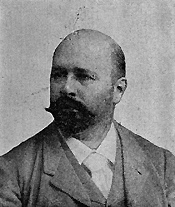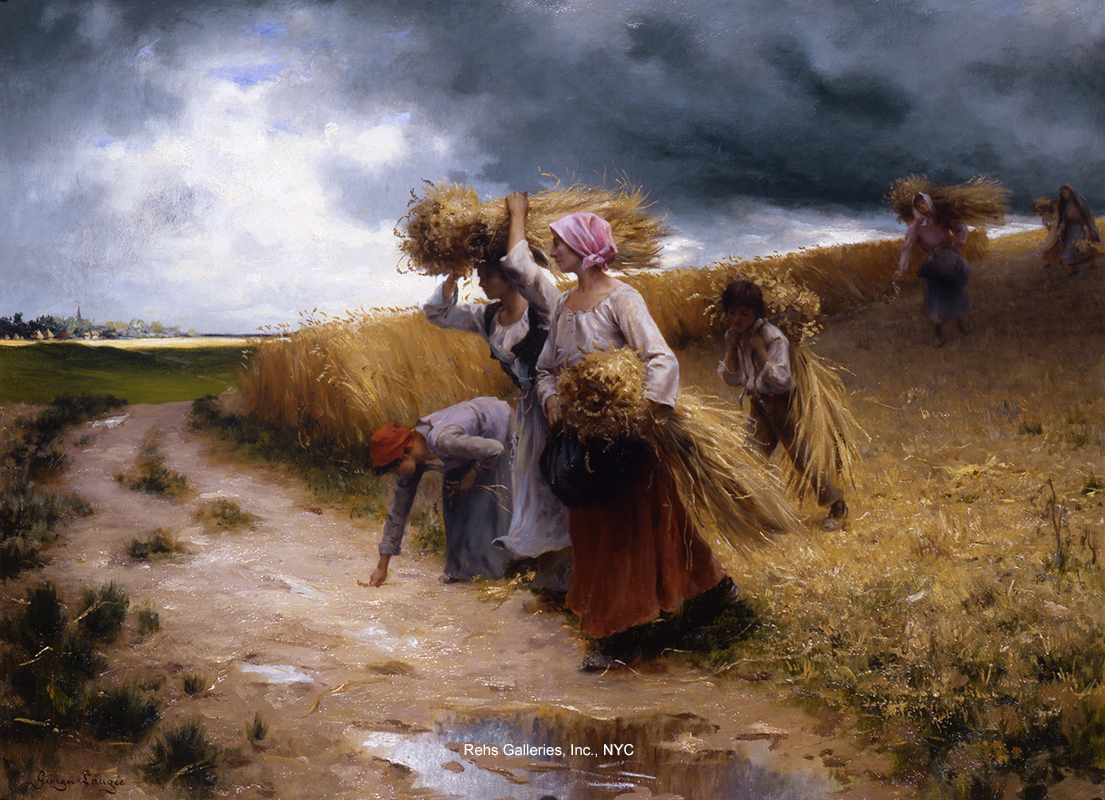Georges François P. Laugée
(1853 - 1937)
A l'Approche du Grain
Oil on canvas
23 1/2 x 32 inches
Signed
BIOGRAPHY - Georges François P. Laugée (1853 - 1937)

Georges Paul François Laurent Laugée was the third of five children−and the only son−of the painter Désiré-François Laugée and his wife, Célestine Marie Malézieux Laugée. Born on December 19, 1853 in Montivilliers, just east of the port of Le Havre, Laugée’s childhood was spent in both Paris and in Picardy where his mother’s family had a country home. The artist’s father was also from this region, having been raised in the town of Saint-Quentin where he received his first instruction in the visual arts. In 1840, at age seventeen, Désiré-François Laugée had moved to Paris to study at the Ecole des Beaux-Arts under the guidance of François-Edouard Picot. Ten years later, he had not only established himself as a successful painter at the Paris Salon, but had married Célestine Marie Malézieux whom he had met in his hometown. As their family began to expand, the couple moved back to Picardy, settling in the village of Nauroy just a few miles from Saint-Quentin, although they maintained a residence in Paris as well.
All five of the Laugée children seem to have received art instruction from their father, and three of them pursued careers in the visual arts. As the only boy, however, Laugée was especially encouraged in his study of painting, and with his father’s encouragement, he attended the Ecole des Beaux-Arts beginning in 1870. Although his studies were interrupted by the onset of the Franco-Prussian War in that same year, and the subsequent civil war known as the Paris Commune in 1871, he resumed his education as soon as possible. He began as a student of Isidore Pils, who had received his own training in the same studio as Laugée’s father, and after Pils’s death in 1875, Laugée continued his instruction under Henri Lehmann.
It was at the Ecole that Laugée met another young artist, Julien Dupré (1851-1910) who would become a lifelong friend and colleague. Like Laugée, Dupré came from a family of artists and both men had been imbued with the Realist ideas of their elders’ generation. As students in the 1870s, they were also influenced by the Impressionist ideas that were being introduced in a series of independent exhibitions between 1874-1886. Ultimately, both Laugée and Dupré emerged as naturalist painters, blending academic technical training with Realist subject matter and an Impressionistic handling of light. Unlike either Realism or Impressionism, naturalism was not a formal movement, but an international sensibility that combined a concern for the depiction of ordinary working people with formal aesthetic elements that captured the subject in the context of the modern world. Like many of his French naturalist colleagues, Laugée’s focus was primarily on rural life−whether domestic scenes of beautiful young peasant mothers or grittier images of farm workers dragging themselves home at the end of a day of back-breaking labor. [i]
On a personal level, Dupré became Laugée’s brother-in-law on May 17, 1876 when he married the painter’s eldest sister, Marie Eléonore Françoise. At that time, Dupré was living in Picardy and pursuing his art education under the guidance of Laugée’s father. Throughout their lives, the two men would live in close proximity to each other in the 16th arrondissement in Paris and share a studio at 20 boulevard Flandrin.
Laugée’s career was launched with his debut at the Paris Salon in 1877. He continued to exhibit his work there regularly, and was awarded bronze medals for En Octobre and Pauvre aveugle in 1881; the following year, En Octobre was also included in an exhibition in Vienna, thus establishing Laugée’s artistic reputation outside of France. In 1889, at the phenomenally successful Exposition Universelle in Paris, Laugée again received a bronze medal for painting.
With his career well on the path to a promising future, Laugée married Evangéline Jermina Fallet (known as Eva) on February 19, 1887 at Clermont sur Oise. Her father was a professor of English at the Lycée Henri Martin in Saint-Quentin, the same city where Laugée’s family was located. Eva was trained as a musician, and apparently composed a trio for organ, violin and cello for their wedding. The newlyweds settled in Paris, where their daughter, Denise Désirée Françoise, was born a year later in 1888.
The decade of the 1890s brought continued success and more international acclaim. Laugée’s painting In the Springtime of Life was part of the French art exhibition at the World’s Columbian Exposition in Chicago in 1893, and it was singled out for particular notice in William Walton’s guide to the art and architecture at the fair. His commentary places Laugée’s canvas squarely within the context of a naturalist aesthetic: “More of these humble folk, artfully arranged but with very little artificial glossing over of their awkward rusticity, may be seen in George (sic) Laugée’s “In the Spring-time of Life”, a very upright and much embarrassed pair facing each other in a pleasantly illuminated bit of greenery. Bastien-Lepage was one of the first to render this subtle charm of the tender passion burning sweetly through an uncouth exterior, like the flame of a horn lantern, as it were.” [ii] Interestingly, this same painting received a silver medal seven years later at the 1900 Exposition Universelle in Paris.
Critical and public recognition was also evident in the use of Laugée’s images in publications such as Famous Paintings of the World, an early form of introductory art historical textbook, published in 1894. In this case, the authors chose to illustrate Bergere et Mouton, a “charming picture” of a shepherdess and her favorite lamb. “It is a simple story the artist has chosen to tell; but he has set it in a scene of tender and idyllic beauty, thoroughly appropriate to the gentle theme of affection he has selected for the central thought.” [iii]
Concomitant with Laugée’s visibility in both art exhibitions and print media was his popularity with art collectors. As with many other French artists, his work was particularly sought after in the US; the American passion for contemporary French art had been fueled not only by the World’s Columbian Exposition in 1893, but also by the growing presence of European art dealers opening galleries in major cities from New York to San Francisco. In 1906, for example, Laugée’s painting, Coming Through the Rye, was illustrated in the catalogue for a large auction at the American Art Association in New York. The title of the catalogue explains the context clearly: Illustrated Catalogue of an Important Collection of Modern Paintings:Belonging to the Following Private Owners, Peter A. Schemm, Moses Tanenbaum, William Salomon, Solomon Mehrbach, Louis A. Biddle and the Estate of the Late Henry Steers. [iv]
Further accolades followed in 1907 when the artist was elected as a Member of the Committee of the Société des Artistes Français; and again in 1908 when he was appointed as a member of the jury at the Salon. However, the first decade of the twentieth century also brought sorrow in 1909 when Laugée’s mother died (his father had died in 1896), and in April 1910 when his close friend and brother-in-law, Julien Dupré died.
Little is known about Laugée’s life during the war years of 1913-1918, although he and his wife must have been deeply concerned about the welfare of their families in Saint Quentin, which was occupied by the Germans in September 1914. The population was evacuated in 1916, and the city was then looted; 80% of its buildings were destroyed or damaged. It is unlikely that Laugée’s family and friends would have escaped this destruction.
Simultaneous with this time of personal devastation, Laugée’s artwork was continuing to attract a growing audience through the vehicle of children’s textbooks in the US. What had begun with the 1894 publication of Famous Paintings of the World expanded to an “art reader” for children in the Boston region in 1904; Ellen M. Cyr developed a series of textbooks intended to introduce grade school students to art history; and Laugée’s painting, Milking Time, was included in the Cyr Graded Art Readers, Book Two. As Cyr explained her goals, “the artist, like the poet, perceives a delicate meaning in the humblest scenes which may surround him. The child with his vivid imagination is susceptible to these impressions, and can soon learn to recognize truth and beauty as presented to him in pictures.” [v]
Following Cyr’s example, Jennie Hall prepared an illustrated textbook for the students at the Francis W. Parker School in Chicago in 1917. Hall’s goal was slightly different in that she combined paintings with poetry for older students and presented them as part of a progressive educational curriculum. Laugée’s The Preferred One was paired with Christina Rossetti’s poem “Snowdrop and Lamb”. [vi]
Life in 1920s Europe was profoundly different from the pre-World War I environment. France alone lost 1,697,800 soldiers and civilians to the war−4.29% of its population. The economic, cultural and social fabric of life changed dramatically. In the art world, the naturalism of Laugée and Dupré was of little interest to the dadaists and surrealists whose lives had been shaped by destruction on a massive scale. Not surprisingly, Laugée and his wife decided to leave Paris in 1930 and retire to Boullarre-par-Betz in Picardy. The painter was losing his sight by then, although he continued to paint small sketches during his last years. He died on December 5, 1937 and was buried in the family tomb at Passy Cemetery near Paris. His wife Eva lived until 1958, dying in Liverpool just twenty-two days short of her 100th birthday.
Janet Whitmore, Ph.D.
Selected Museums
Hollytrees Museum, Colchester and Ipswich Museums Service, Colchester, Essex
Musée de Picardie, Amiens, France
Musée des Beaux-Arts, Nantes, France
Musée des Beaux-Arts, Boulogne-sur-mer, France
Musée des Beaux-Arts, Rouen, France
Musée des Civilisations de l'Europe et de la Méditerranée, Marseilles
[i] For a comprehensive discussion of European naturalist painting, see Gabriel P. Weisberg, Illusions of Reality: Naturalist Painting, Photography and Cinema, 1875-1918, ex. cat., (Amsterdam: Van Gogh Museum, 2011).
[ii] William Walton, World's Columbian Exposition MDCCCXCIII. Official illustrated publication, Art and Architecture [Columbus Edition], Vol. 1., (Philadelphia : G. Barrie, 1893.) 43.
[iii] Lew Wallace, John Clark Ridpath and Will Carleton, Famous Paintings of the World (New York: Bryan, Taylor and Co., 1894).
[iv] Peter A. Schemm, Illustrated Catalogue of an Important Collection of Modern Paintings:Belonging to the Following Private Owners, Peter A. Schemm, Moses Tanenbaum, William Salomon, Solomon Mehrbach, Louis A. Biddle and the Estate of the Late Henry Steers; to be Sold March 1 and 2, 1906. Auction catalogue, (New York: American Art Association, 1906). Laugée’s painting is cat. no. 40.
[v] Ellen Cyr, Cyr Graded Art Readers, Book Two (Boston: Ginn & Company, 1904) v.
[vi] Jennie Hall, Weavers and Other Workers (Chicago: Rand McNally & Co., 1917) 83.

